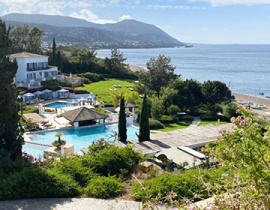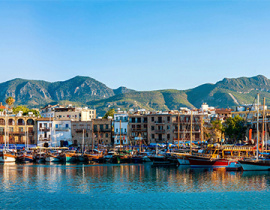- Home
- Blog
- Area Guide
- Unveiling Gazimağusa North Cyprus: History, Culture, and Mystery
Unveiling Gazimağusa North Cyprus: History, Culture, and Mystery
Gazimağusa, also known as Famagusta or Magusa, is one of the favorite holiday destinations in Northern Cyprus, and it’s easy to see why. Filled with long sandy beaches, natural treasures, and historical landmarks, Gazimağusa has what any holidaymaker needs, whether it be a relaxing scene, history, or an exciting adventure.
.jpg) If you are looking for a new place to spend your next holiday, this guide is for you. The content covers the best beaches, attractions, and historical significance of Gazimağusa, North Cyprus.
If you are looking for a new place to spend your next holiday, this guide is for you. The content covers the best beaches, attractions, and historical significance of Gazimağusa, North Cyprus.
Key Facts About Gazimağusa Cyprus
Gazimağusa is a port city located on the east coast of Turkish Cyprus. Home to around 1,300,000 people (2025 est.), Gazimağusa features a cosmopolitan population of Turkish Cypriots, Turkish settlers, Greek Cypriots, and international expats (Russians, Iranians, Ukrainians, and Middle and Far East).
Gazimağusa's weather is perfect for holidays. The heat peaks in August, with an average temperature of 22°C to 32°C. The coldest month is January, ranging from 7°C to 16°C. While summer months don’t experience much rain, it might rain from late October to late March. So, you can expect a sunny season of 7 full months.
Famagusta Cyprus | History
Gazimağusa owns a unique character that is built upon its years of history. There are several key events that shaped today’s culture in Gazimağusa. These events go back to around 300 BC, after a major earthquake destroyed the nearby city of Salamis, and a fishing village was established in the area. In 1291, Christian refugees arrived from Palestine, turning Gazimağusa into one of the wealthiest cities in Europe. Over the centuries, Gazimağusa came under the control of many different powers. Byzantines, Arabs, Lusignans, Genoese, Venetians, Ottoman Turks, and the British left significant landmarks. Since 1974, Famagusta has been part of the Turkish Republic of Northern Cyprus (TRNC).
Today, the city skyline is ornamented with modern buildings and medieval landmarks integrated together. From a ghost town to medieval castles, every detail here is worth exploring.
Top 10 Historical Attractions in Gazimağusa
Here are the top 10 historical places to visit in Gazimağusa:
- Famagusta Old City / Famagusta Old Town
.jpg) Originally built by the Lusignans in the 1300s, the Old Town of Famagusta has witnessed several important events. Once a medieval port city, the area was later fortified with impressive walls, towers, and gates during the Venetian period.
Originally built by the Lusignans in the 1300s, the Old Town of Famagusta has witnessed several important events. Once a medieval port city, the area was later fortified with impressive walls, towers, and gates during the Venetian period.
Today, the Old Town serves as an open-air museum, home to some of Famagusta’s most significant landmarks like Lala Mustafa Pasha Mosque, Othello’s Castle, St. George Church, and Palazzo del Provveditore.
- Othello’s Castle
Othello’s Castle, also known as Famagusta Castle, is a well-preserved medieval fortress at the entrance of Famagusta’s old harbour. Originally constructed by the Lusignans in the 14th century, the castle was later fortified by the Venetians with massive stone walls and towers, offering a glimpse into the military architecture of the Middle Ages.
Many believe that William Shakespeare was inspired by this glamorous castle in creating the setting for his tragic play Othello.
- Ghost Town of Varosha
Varosha, also known as Famagusta Ghost City, was once an important port city and a prime holiday destination during the 1950s and 60s. However, the town was abruptly abandoned in 1974 during the Cyprus conflict.
After decades of closure, parts of Varosha in Famagusta, Cyprus were reopened to visitors in 2020. Today, you can walk around the streets and explore parts of its beaches. Photography is allowed in most areas, unless there is a sign to the contrary. Note that entering buildings and taking any objects is prohibited.
Filled with history, every corner of Varosha has a unique story to explore. To experience its atmosphere more deeply, consider joining Famagusta Ghost Town tours.
- St. Nicholas Cathedral / Lala Mustafa Pasha Camii
Built between 1298 and 1400, the Famagusta Cathedral is one of the finest examples of Rayonnant Gothic architecture in North Cyprus. The structure is known for its glamorous stonework, arches, and stunning towers/minarets.
.jpg) Originally constructed as a Roman Catholic cathedral, the building was later converted into a mosque during Ottoman rule and renamed Lala Mustafa Pasha Mosque, Famagusta. During this process, many Christian objects were removed, and the building was restored in accordance with Islamic rules. Today, the structure reflects Cyprus’s cultural complexity and the historical transformations it has gone through over the centuries.
Originally constructed as a Roman Catholic cathedral, the building was later converted into a mosque during Ottoman rule and renamed Lala Mustafa Pasha Mosque, Famagusta. During this process, many Christian objects were removed, and the building was restored in accordance with Islamic rules. Today, the structure reflects Cyprus’s cultural complexity and the historical transformations it has gone through over the centuries.
- Famagusta City Walls
Encircling the historic Famagusta Old City, the city walls stand out as another well-preserved medieval heritage. Built by the Lusignan kings in the 13th to 14th centuries, the walls were dramatically reinforced throughout history.
We suggest you take your time discovering the city walls. A stroll along the ramparts, bastions, and gates might reveal unique scenery.
- Salamina / Ancient City of Salamis
Dating back to 1100 BC, the Ancient City of Salamis has a rich history shaped by civilizations like the Assyrians, Egyptians, Persians, and Romans. Over the centuries of occupations, major earthquakes, and transformation, Salamis became one of the most important ancient cities in North Cyprus.
Archeological findings on the site include gold coins dating from 411-374 BC, as well as columns erected by Trajan, Hadrian, and early Christian communities. Today, visitors can explore the ruins of Salamis Theatre, Salamis Gymnasium, Roman Villa, Byzantine Cistern, Agora, Altar of Zeus, and Cellarga Mass Graves.
- Porta del Mare
Also known as the Famagusta Gate, Porta del Mare is an impressive sea gate completed in 1496 during the Venetian period. Reflecting the style of Italian Renaissance architecture, the gate once guarded the main maritime entrance to the walled city.
Above the archway stands a well-preserved medieval writing. Another remarkable feature of the gate is a marble statue of the winged Lion of St. Mark. The lion holds an open book bearing the Latin phrase:
- "Pax tibi Marce, Evangelista Meus” (Peace be upon you, Mark, my Evangelist).
- Monastery of Apostle Barnabas / St. Barnabas Monastery & Icon Museum
.jpg) St. Barnabas Monastery serves as a symbol of Cyprus’s deep spiritual roots. First built in 477 AD, the monastery once included stoas, gardens, and hostels for pilgrims. Its original basilica was destroyed during the Arab raids in the 7th century. The current church was rebuilt in 1756.
St. Barnabas Monastery serves as a symbol of Cyprus’s deep spiritual roots. First built in 477 AD, the monastery once included stoas, gardens, and hostels for pilgrims. Its original basilica was destroyed during the Arab raids in the 7th century. The current church was rebuilt in 1756.
As the home of two monks between 1971 and 1974, the monastery was an active religious institution until the Cyprus conflict. It now features an Icon Museum, which displays artworks and the tomb of St. Barnabas. The archaeological museum showcases artifacts from the Neolithic to the Roman eras, including pottery, bronze items, and glassware.
- Venetian Palace Ruins / Palazzo del Provveditore / Venetian Royal Palace
Palazzo del Provveditore reflects centuries of layered history. Originally built between 1300 to 1302 in Gothic style, the palace was first a royal residence for the Lusignan kings. After surviving a major earthquake in 1369, the palace was severely damaged and renovated by Venetians between 1552 and 1554, adopting an Italian Renaissance style.
Throughout its lifetime, the building served multiple purposes, including an Ottoman prison. Today, the palace serves as a museum, with a triple-arched entrance, a governor’s chapel, and courtyard walls.
- Namık Kemal Dungeon Museum
The Namık Kemal Dungeon Museum honors one of the most prominent literary figures of the Ottoman era, Namık Kemal, a writer, poet, and political thinker known for his patriotic themes.
In 1872, following the staging of his play Vatan Yahut Silistre (Fatherland or Silistra), Namık Kemal was exiled for allegedly inciting rebellion against the sultan. Located adjacent to the Venetian Palace ruins, this building is where the writer was held from 1873 to 1876.
The structure was converted into a museum in the 1990s, offering insight into his life, works, and political significance. Today, the city still honors him with a bronze bust and a square named after him.
Best Beaches in Famagusta, North Cyprus
Here are some of the best beaches in Famagusta:
- Palm Beach, Famagusta
.jpg) Located just near Famagusta Old Town and Varosha Ghost City, Palm Beach is a great spot after a day visiting the historical sites. The backdrop of the beach highlights deserted hotels and natural surroundings, which creates a unique scene for visitors.
Located just near Famagusta Old Town and Varosha Ghost City, Palm Beach is a great spot after a day visiting the historical sites. The backdrop of the beach highlights deserted hotels and natural surroundings, which creates a unique scene for visitors.
Palm Beach is known for its calm and clean waters, attracting families. Visitors can rent sun loungers and umbrellas and enjoy snack bars and coffee shops. The beach hosts several people a day, especially in summer. You can guarantee a calm environment by visiting during the early hours.
- Glapsides Beach
Located in the north of the city, Glapsides Beach is a spacious, golden-sanded beach with calm and shallow waters. The beach has snackbars and sunbeds, umbrellas, and paddleboard rentals. It has a great location close to the Salamis Ruins.
- Silver Beach
Located in the north of Gazimağusa, Silver Beach is a tranquil gem known for its soft white sands and peaceful ambiance. The beach has a safe and family-friendly atmosphere. It is popular for snorkeling. Visitors can enjoy a beachside culinary experience in the restaurants.
Day Trips from Gazimağusa
Travel agencies in Famagusta offer several exciting daily tour packages for travelers. These tours typically include hotel pickup and drop-off as well as professional guides and often food and drink.
Complete Famagusta trips are ideal for discovering the city’s rich history and vibrant culture. Some tours cover all attractions, from Salamis Ruins to Othello’s Castle and Varosha.
If you like swimming, boat trips are also perfect for you. These tours offer a chance to explore scenic bays and swim in historic beaches.
Cuisine in Gazimağusa
.jpg) Gazimağusa offers a rich culinary experience influenced by Turkish, Greek, and Mediterranean traditions. Local specialties include pirohu, peach kebab, kleftiko, magarina bulli, walnut paste, and molehiya.
Gazimağusa offers a rich culinary experience influenced by Turkish, Greek, and Mediterranean traditions. Local specialties include pirohu, peach kebab, kleftiko, magarina bulli, walnut paste, and molehiya.
Here are the best restaurants in Gazimağusa:
- Castello Cyprus Bar
- Niazi’s Restaurant
- Eziç Mağusa Restaurant
- Othello Meze Restaurant
- The Palm House Restaurant
Where to Stay in Gazimağusa?
Whether you are looking for a luxurious 5-star hotel or a cozy, authentic guesthouse, you can choose from a variety of places to stay in Gazimağusa.
If you are dreaming of an upscale holiday environment, we suggest you stay in Ayia Napa, Famagusta, Cyprus, filled with beach clubs, fine dining restaurants, and top-notch hotels.
The best of Gazimağusa hotels include Salamis Bay Conti, Arkin Palm Beach Hotel, and Limak Cyprus Deluxe Hotel. These hotels are known for their all-inclusive packages, delicious food, relaxing activities, and good service. You can consider La Regina Veneziana Guest House, Golden Palms Guest House, or Altun Tabya Hotel if you prefer a budget-friendly stay.
Alternatively, you might consider renting a holiday home. Many villas in Gazimağusa include private pools, sun terraces, and spacious gardens. Choosing a central location will ensure you enjoy your holiday to the maximum.
Before booking your trip, it's also wise to check practical details like travel documentation, restrictions, and visa requirements. For up-to-date information, visit our guide for travel requirements in North Cyprus.








